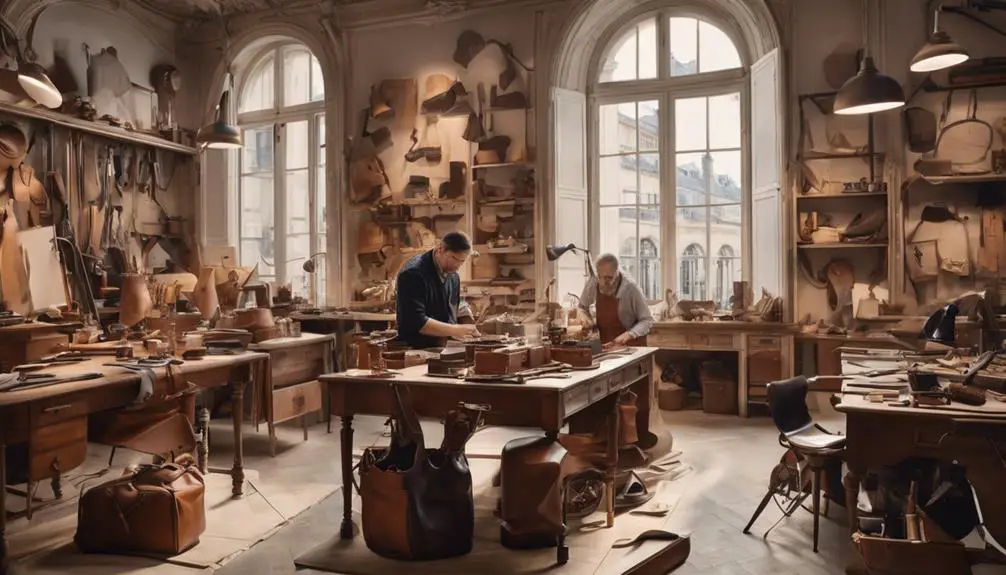The House of Hermès has had many famous moments that highlight its luxurious heritage. Founded in 1837 as a harness maker for the elite, it quickly gained fame at the 1867 Universal Exhibition in Paris. It launched iconic products like the Kelly bag in 1935 and the Birkin bag in 1984, both embodying exclusivity. The 150th anniversary in 1987 featured a spectacular fireworks display, solidifying its cultural significance. Throughout, Hermès has mixed tradition with innovation while embracing sustainability, ensuring lasting appeal. There's so much more to explore about Hermès' legacy, waiting just beyond the surface.
Historical Foundations of Hermès

When you explore the historical foundations of Hermès, you'll discover a legacy that began in 1837, when Thierry Hermès established the company in Paris. Initially, Hermès specialized in crafting high-quality harnesses and bridles, catering to the needs of European nobility. This focus on superior craftsmanship set the tone for what would become a renowned brand.
The company's reputation soared after its recognition at the 1867 Universal Exhibition in Paris, where it received awards for its technical achievements. This prestigious event showcased the exceptional skill and dedication to quality that Thierry Hermès instilled in the brand.
In 1880, his son Charles-Émile Hermès relocated the workshops to 24 Faubourg Saint-Honoré, further solidifying Hermès' status in the world of custom saddlery.
As the years progressed, innovation played a key role in Hermès' evolution. In 1922, Émile Hermès introduced the zipper system, marking a significant leap in product functionality and design.
This inventive spirit carried into the interwar period, during which the brand diversified into leather goods and accessories. Hermès drew inspiration from art and curiosities, enhancing product design and continuing the tradition of exceptional craftsmanship.
Today, when you think of Hermès, you think of a rich history that combines artistry, innovation, and a commitment to quality. This foundation laid the groundwork for the iconic products that would follow, showcasing the brand's enduring legacy.
Iconic Product Launches
Iconic product launches have defined Hermès' reputation as a leader in luxury fashion. Since the early days, Hermès has captivated the world with its innovative creations. For instance, the first silk scarf introduced in 1937 quickly became a staple, selling one scarf every 20 seconds globally. This product's success highlights how Hermès expertly combines artistry with practicality.
Then there's the legendary Kelly bag, which made waves after its introduction in 1935. It wasn't until 1956, when Grace Kelly famously used it to shield her pregnancy from the press, that it gained its iconic status. This moment not only boosted the bag's popularity but also added a touch of elegance to its allure.
The Birkin bag, born from a serendipitous conversation between actress Jane Birkin and Jean-Louis Dumas in 1984, took exclusivity to new heights. With a waiting list stretching up to six years, the Birkin bag has become a symbol of luxury goods that few can possess.
Hermès' commitment to innovation didn't stop there. In 1949, the fashion house expanded its offerings to include ties, responding directly to customer demand observed at the Cannes Film Festival. This adaptability showcases how Hermès continues to evolve while maintaining its rich heritage.
Through these iconic product launches, Hermès has solidified its place in the world of luxury fashion, ensuring that each item carries a story of craftsmanship, exclusivity, and timeless style.
Leadership Changes and Growth

Leadership changes at Hermès have greatly shaped its growth trajectory and brand identity. In 1951, Robert Dumas took the reins, leading the brand to notable successes. Under his guidance, Hermès introduced its first silk scarf and the iconic Kelly bag, solidifying its reputation for luxury and exclusivity. He even renamed the company to Hermès Frères, emphasizing its focus on high-profile clientele.
When Jean-Louis Dumas joined in 1964, he revitalized the brand, overseeing expansion into new product lines and markedly increasing revenue. His leadership not only maintained Hermès's prestigious status but also showcased its commitment to craftsmanship.
Following Jean-Louis's retirement in 2006, Patrick Thomas stepped in, ensuring a smooth changeover and continuity in the brand's vision.
In 2013, Axel Dumas became Executive Chairman, bringing fresh ideas to the table. He pushed for group growth by focusing on omnichannel dynamics, which helped Hermès adapt to the changing retail landscape while still emphasizing its artisanal roots. This blend of tradition and innovation keeps Hermès firmly positioned in the luxury market.
Each leadership change has contributed to Hermès's enduring legacy, demonstrating how strategic direction and a commitment to quality can drive growth. As the brand continues to evolve, it remains dedicated to its heritage of craftsmanship, ensuring that products like the Kelly bag remain symbols of style and sophistication.
Through these changes, Hermès has managed to stay relevant and influential in the world of luxury.
Cultural Celebrations and Impact
Throughout its history, Hermès has embraced cultural celebrations that underscore its deep-rooted heritage and artistic influence. These moments not only honor the brand's legacy but also engage communities worldwide, creating a lasting cultural impact.
Here are a few remarkable celebrations:
- 150th Anniversary (1987) – A spectacular fireworks display lit up the night sky over the Pont-Neuf bridge in Paris, celebrating Hermès' rich history.
- Le Monde d'Hermès (1973) – This journal captures the essence of the brand, showcasing various artistic themes that inspire Hermès products and inviting readers into its world.
- Annual Themes – Each year, Hermès introduces a theme that sparks creativity and innovation across its product lines, fostering a dialogue with contemporary art and culture.
- Philanthropic Initiatives – Through the Fondation d'entreprise Hermès, the brand focuses on creation, transmission of know-how, and environmental preservation, reinforcing its commitment to community and heritage.
Commitment to Sustainability

Hermès has made a significant commitment to sustainability, demonstrating how luxury and environmental responsibility can coexist. Since 2008, the brand has focused on enhancing its patronage and philanthropy through the Fondation d'entreprise Hermès, emphasizing creation, traditional craftsmanship, and environmental preservation. This foundation showcases how Hermès values both artistry and the planet.
A key initiative within this commitment is the Petit h workshop, launched in 2010 under Pascale Mussard's leadership. This innovative workshop repurposes unused materials from Hermès' manufacturing processes, turning them into high-quality, sustainable objects. By creatively transforming waste into new products, Hermès not only reduces waste but also champions the idea that luxury can be both beautiful and responsible.
Hermès actively integrates sustainability into its business model by using natural materials that enhance product longevity and minimize environmental impacts. This dedication was recognized in 2018 when Hermès entered the CAC40 index, affirming its artisanal growth model while adapting to sustainable market practices.
The brand's ongoing initiatives reflect a strong focus on resourcefulness, aiming to reduce waste and promote recycling across its operations. By blending traditional craftsmanship with modern sustainability practices, Hermès sets an example for the luxury industry, proving that it's possible to honor the past while innovating for the future.
You can see how their commitment not only enriches their products but also contributes positively to our environment, making luxury a more sustainable choice.


